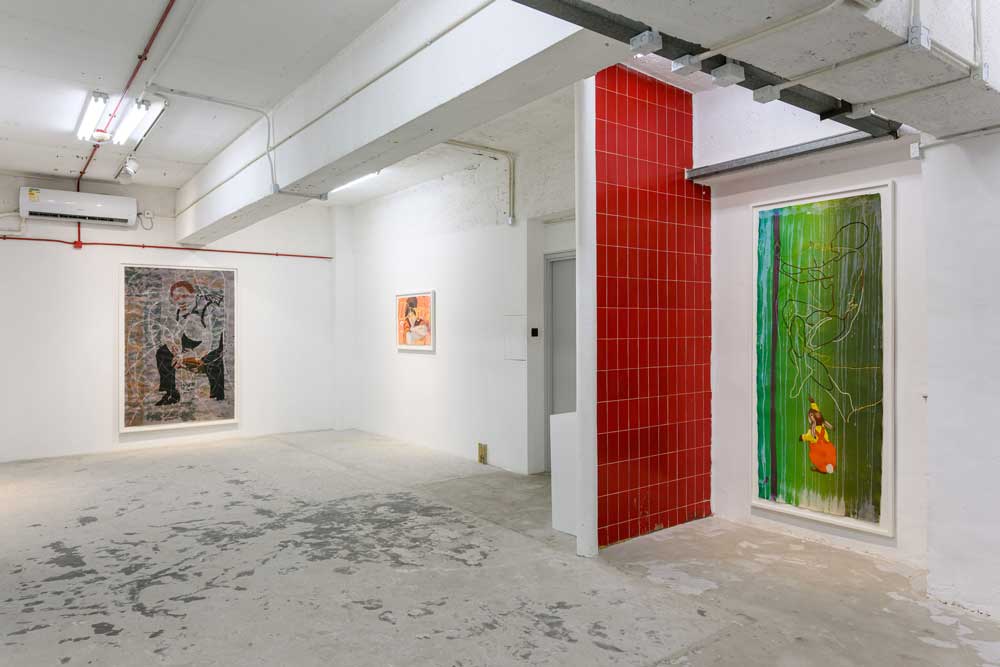展期 Period:
2024.5.17—2024.6.29
艺术家 Artist:
地点 Venue:
马凌画廊 Kiang Malingue(香港田湾)
前言 Introduction:
无题(血肉、缝线及其他生料)
森·摩
i:血肉
身体在坠落。在呼啸的狂风和身边飞升而过的建筑之间,它从未有过如此激烈的感受。四肢外张,这人想要攫取能够为这感觉下定义的事物,在考虑「天恩」是否是合适的描述词汇。一池血水逐渐从头脑后方蔓延开来。它的确是个值得驻足观察的景观。这身体缓慢而笃定地被打开,使它得以凝聚为一体的事物的碎片是如此地清晰可见。从伤口中渗出的不只是血;它的灵魂以及它为自身建构的自我意识也在四散流出。每一滴血都是这位不知应往何处去的人掉落的碎片。它所了解的事,它所能仰仗的,不过就是来时路,以及它过去曾变成的模样。见红之后,它希望它仍然能够再次发生变化。坠落只是一次开始,而那沉重响亮的落地过程并不比接下来发生的事情要更痛苦:因重新被拼凑为一个整体而做出的、难以抑制的、绝望的涂写,深入挖掘。
ii:缝针
它惊叹于镜中所见的伤疤;脑后又深又长的口子。如果它看得够仔细,它就能一瞥那让伤口不至于四分五裂——让它不至于四分五裂——的缝线。每当看见这情景,它就忍不住想要扯开缝线,去试探再度分离瓦解身体的状况。它使劲,短促地拉了一下这缝线。线的张力让它想起坠落的感觉,想起在山顶的感觉——人总是能想起自己的负担的——不从暴力的坠落过程中寻找平静,而是因这一意识而感到平静:它总能复归,身体总不像它最初想像的一般终极、有限。它剪了头发,并确保所有人都能清晰看见它头上的伤疤和缝线。去展现我们得以成为整体的方式,这是一件内藏力量的事情——胡乱拼凑而成的、伤疤与缝线的集合体,这型态总想要比原初塑形的方式更为强大,总想要比血肉更为具有延展性。
iii:其他生料
深度个人化的文献库:《六度分隔》剧作的海报;Simply Red乐队的唱片封面;难以辨认的、涉及X-Ray Spex乐队的文字。这些是挑战了事物面貌的飘渺文字、质询了名字意义的多层次参考图像,而难以被解读似乎就是其本身的意义。现成图像变得更为具象,更为富有情感力量;变成了用以(重新)塑造事物的工具。用以作画的纸张看起来都是被缝合在一起的,或是被复写了的。自我意识可能根本就不存在,最起码不以实在的方式存在;它变成了重复书写的羊皮纸,变成了Prince的歌词——从原本语境中剥离出来,在别处使用,就像是以全新的方式说出的语言一样。
untitled (gore, stitches, and other raw materials)
By Sam Moore
i: gore
The body is falling. Between the gusts of wind and the way that buildings soar past them as they plummet, this feeling is unlike anything else they’ve ever felt. With outstretched limbs, they reached for something to define this feeling, wondering if grace sounded right. There is a pool of blood slowly expanding outwards from the back of their head. The body is a sight to behold. The body is, slowly but surely, being opened up, the fragments of what kept it together made viscerally clear. It is more than just blood that seeps out of the wound; it is the soul, the self that they constructed for themselves. Each drop of blood another fragment of someone who no longer knows where they’re going. All they know, all they can hold on to, is where they’ve been, who they became. Seeing red, they hope that they might become, again. The fall was just the beginning, and even that dull thud didn’t hurt as much as what comes next; that impulsive, desperate scrawl, the digging deep, of being put back together again.
ii: stitches
They admire the scar in the mirror; a long, deep gash on the back of their head. If they look at it closely enough, they can see the suture that holds it—them—together. Whenever this happens, they’re tempted to pull at it, to see what happens if they come apart again. They give it a short, firm tug. The tension on their sutures brings them back to that feeling of falling, back at the top of the hill—one always finds one’s burden again—finding peace not in their brutal descent, but the knowledge they can go back again, their body not as final or finite as they first imagined it to be. After getting a haircut, they wanted to make sure that the scar, the suture, was visible to anyone that might look their way. There is power in being able to point to the ways in which we’ve been put together, a hastily assembled mass of scars and stitches, constantly striving to become more than the things which first held us together; more malleable than we might ever imagine flesh and blood to be.
iii: other raw materials
A deeply personal archive: the playbill for a production ofSix Degrees of Separation; the cover of an album by Simply Red; a barely legible line of text that makes reference to X-Ray Spex. The point seems to be that these errant words, these layers of references, challenging how faces look, or what’s in a name, are difficult to decipher. Source material becomes less abstract and more visceral; a tool through which things might be (re)made. Even the paper looks as if it’s been stitched together, or overwritten. The sense of self might not even exist, at least not in a concrete way; instead, it becomes a palimpsest, the verse of a Prince song ripped from context and used elsewhere, like language being spoken anew.

